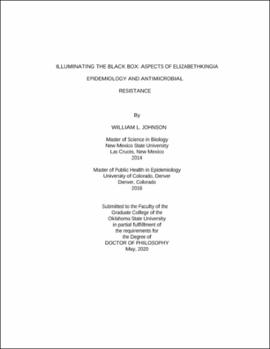| dc.contributor.advisor | Gustafson, John E. | |
| dc.contributor.author | Johnson, William L. | |
| dc.date.accessioned | 2020-09-09T21:16:22Z | |
| dc.date.available | 2020-09-09T21:16:22Z | |
| dc.date.issued | 2020-05 | |
| dc.identifier.uri | https://hdl.handle.net/11244/325480 | |
| dc.description.abstract | Elizabethkingia are emerging Gram negative opportunistic pathogens and the etiologic agents of community- and hospital-associated outbreaks in immunocompromised patients. These organisms are notable for the multiply-antibiotic resistant phenotypes all known members express. While vancomycin is normally ineffective against infections caused by Gram negative organisms, this antibiotic has been reported to effectively treat Elizabethkingia infections. Despite increasing interest in these organisms, the epidemiology, along with mechanisms by which antimicrobial agents, particularly vancomycin, may act on these organisms, and how these organisms might acquire resistance to vancomycin, remains poorly understood. | |
| dc.description.abstract | I initially investigated the genomic and antimicrobial profiles of two Elizabethkingia anophelis isolates associated with horses. Next, to better understand the interaction of antimicrobial agents, particularly vancomycin, with Elizabethkingia, I challenged a collection of 21 isolates, including 2 isolates from horses in Oklahoma, representing the 6 currently described species with vancomycin alone and in combination with other antibiotics. I then assessed how vancomycin challenge impacts the type strain of Elizabethkingia anophelis, R26, using RNAseq. Finally, I investigated the mutations underlying vancomycin resistance and the physiological consequences of these mutations by selecting 8 vancomycin-resistant mutants from 2 different Elizabethkingia species. | |
| dc.description.abstract | Whole genome sequence analysis revealed that the two horse-associated isolates are clonal and closely related to human clinical E. anophelis isolates. These isolates displayed antimicrobial susceptibility profiles that were similar to E. anophelis isolates from human infections in the United States, including susceptibility to fluoroquinolones and resistance to all tested cell wall active antimicrobials. The other projects revealed that vancomycin acts as a bactericidal agent, and likely kills Elizabethkingia through an inhibition of peptidoglycan biosynthesis, and induces a stress response that shares many characteristics of the oxidative stress response. Mutations associated with resistance to vancomycin rapidly arose after a single vancomycin challenge, and these mutants demonstrated altered susceptibility to other antimicrobials and antimicrobial combinations. These mutations uncovered in the vancomycin-resistant mutants occurred in an array of genes, suggesting that vancomycin resistance can arise via multiple pathways. This dissertation represents a collection of research that produced data to allow for multiple courses of future research. | |
| dc.format | application/pdf | |
| dc.language | en_US | |
| dc.rights | Copyright is held by the author who has granted the Oklahoma State University Library the non-exclusive right to share this material in its institutional repository. Contact Digital Library Services at lib-dls@okstate.edu or 405-744-9161 for the permission policy on the use, reproduction or distribution of this material. | |
| dc.title | Illuminating the black box: Aspects of Elizabethkingia epidemiology and antimicrobial resistance | |
| dc.contributor.committeeMember | Ruhl, Donald | |
| dc.contributor.committeeMember | Chen, Charles | |
| dc.contributor.committeeMember | Canaan, Patricia | |
| dc.contributor.committeeMember | Lutter, Erika | |
| osu.filename | Johnson_okstate_0664D_16748.pdf | |
| osu.accesstype | Open Access | |
| dc.type.genre | Dissertation | |
| dc.type.material | Text | |
| dc.subject.keywords | antibiotic | |
| dc.subject.keywords | elizabethkingia | |
| dc.subject.keywords | gram-negative | |
| dc.subject.keywords | resistance | |
| dc.subject.keywords | synergy | |
| dc.subject.keywords | vancomycin | |
| thesis.degree.discipline | Biochemistry and Molecular Biology | |
| thesis.degree.grantor | Oklahoma State University | |
